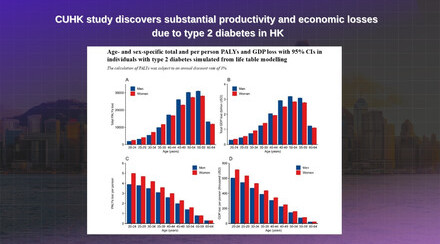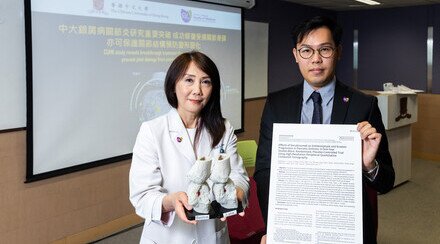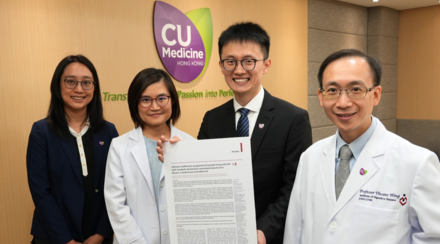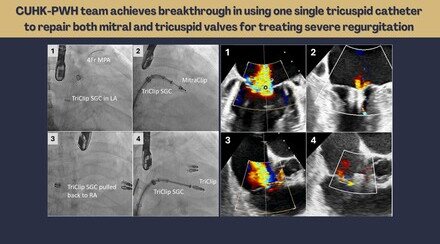CUHK Discovers an Essential Oncogene in Non-Alcoholic Fatty Liver Disease-Associated Hepatocellular Carcinoma
The Faculty of Medicine at The Chinese University of Hong Kong (CUHK) has reported a major discovery in non-alcoholic fatty liver disease-associated hepatocellular carcinoma (NAFLD-HCC). A research team led by Professor Jun YU discovered that genetic engineered mice expressing squalene epoxidase (SQLE) and fed a high-fat, high-cholesterol diet displayed a higher incidence of NAFLD-HCC. The investigators identified a SQLE inhibitor, Terbinafine, which effectively suppressed cell proliferation in NAFLD-HCC cell lines and HCC formation in SQLE transgenic mice. The study published in the international medical journal Science Translational Medicine (18 Apr 2018) as a cover story unveils SQLE as a novel therapeutic target for NAFLD-HCC and provide new directions for the prevention and treatment of this disease.
Novel identification of SQLE as a novel oncogene in NAFLD-HCC
Non-alcoholic fatty liver disease (NAFLD) is a major health problem in the 21st century. It is the most common chronic liver disease worldwide and affects 30% of the adult population in Hong Kong. NAFLD is also one of the leading triggers for liver cancers; however, the mechanism of NAFLD-HCC remains poorly understood and no therapeutic drug is currently available for the prevention or treatment of NAFLD-HCC.
Investigators from this study sequenced 18 pairs of NAFLD-HCC and normal liver tissues and found out that SQLE was highly expressed in NAFLD-HCC. In three independent HCC patient groups, SQLE was also commonly overexpressed in tumor tissues, and high SQLE expression was associated with poor outcomes in HCC patients.
SQLE is an essential enzyme for cholesterol biosynthesis in humans. In cell line and mice models, researchers found that SQLE promoted cholesteryl ester accumulation and induced reactive oxygen stress, which in turn increased cell proliferation.
The research team was the first to construct a genetically-engineered mice model that overexpressed SQLE in liver cells, and studied its impact on NAFLD-HCC development. Study results demonstrated that SQLE transgenic mice had significantly increased incidence of NAFLD-HCC, suggesting that SQLE is an oncogenic factor that promotes NAFLD-HCC.
Study provides new direction for the prevention and treatment of NAFLD-HCC
Terbinafine (SQLE inhibitor) is used for treating fungal infections. Researchers found that Terbinafine suppressed SQLE-induced cholesteryl ester and oxidative stress accumulation, leading to reduced cancer cell proliferation. Besides, Terbinafine treatment in mice with HCC xenografts arrested tumor growth and extended mice survival. Finally, Terbinafine treatment in SQLE transgenic mice effectively reduced incidence of NAFLD-HCC. These results indicate that Terbinafine might be useful for the prevention and treatment of NAFLD-HCC.
Professor Jun YU, Professor of the Department of Medicine and Therapeutics, from the Faculty of Medicine at CUHK led this study. She stated, “Our study showed that the cholesterol biosynthesis gene SQLE is essential for the pathogenesis of NAFLD-HCC. Our work also showed that Terbinafine can be repurposed for the treatment of NAFLD-HCC. We will continue to investigate the efficacy of Terbinafine in NAFLD-HCC, and to translate our findings to the clinic to benefit patient care.”
Publication as a cover story:
“Squalene epoxidase drives NAFLD-induced hepatocellular carcinoma and is a pharmaceutical target” Science Translational Medicine (18 Apr 2018)
http://stm.sciencemag.org/content/10/437/eaap9840.full

Professor Jun YU (centre), Department of Medicine and Therapeutics, Faculty of Medicine at CUHK, first discovered the role of SQLE as an oncogene in NAFLD-HCC. Team members of this study include Dr. Dabin LIU (right) and Dr. Chi Chun WONG.


































































































